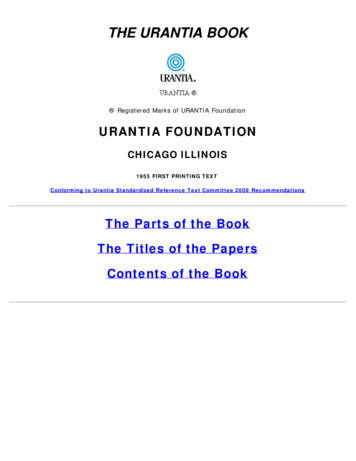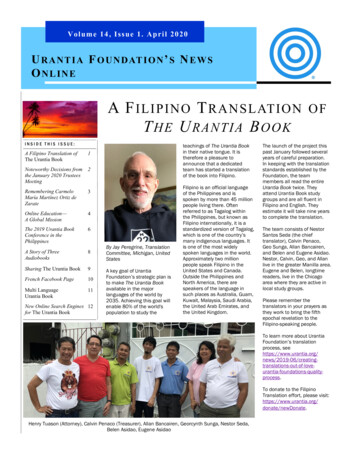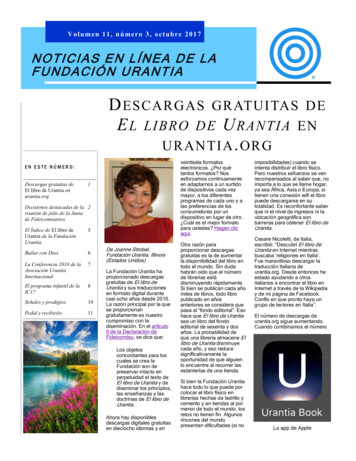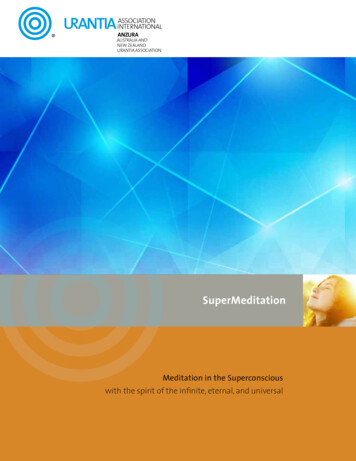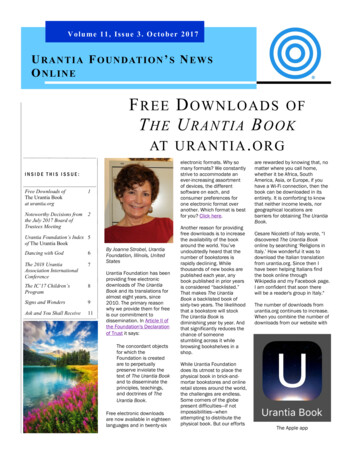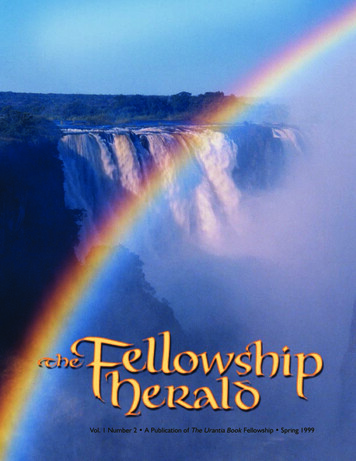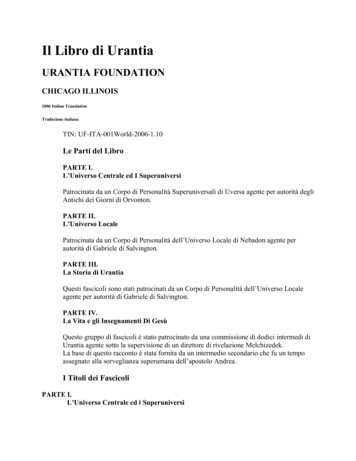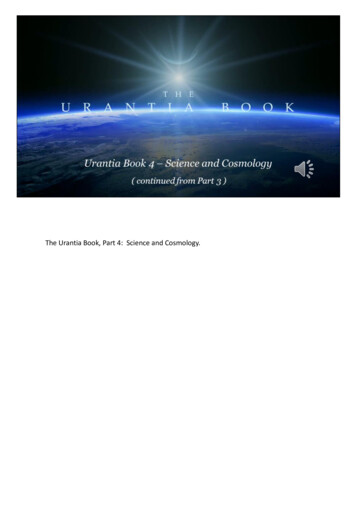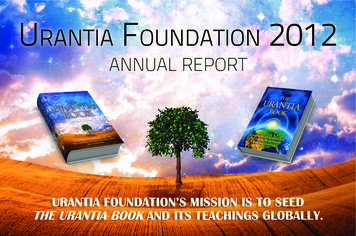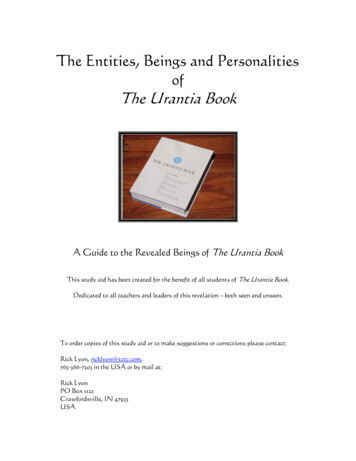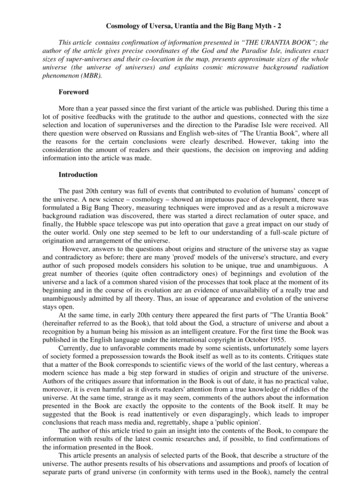
Transcription
Cosmology of Uversa, Urantia and the Big Bang Myth - 2This article contains confirmation of information presented in “ТHE URANTIA BOOK”; theauthor of the article gives precise coordinates of the God and the Paradise Isle, indicates exactsizes of super-universes and their co-location in the map, presents approximate sizes of the wholeuniverse (the universe of universes) and explains cosmic microwave background radiationphenomenon (MBR).ForewordMore than a year passed since the first variant of the article was published. During this time alot of positive feedbacks with the gratitude to the author and questions, connected with the sizeselection and location of superuniverses and the direction to the Paradise Isle were received. Allthere question were observed on Russians and English web-sites of "The Urantia Book", where allthe reasons for the certain conclusions were clearly described. However, taking into theconsideration the amount of readers and their questions, the decision on improving and addinginformation into the article was made.IntroductionThe past 20th century was full of events that contributed to evolution of humans’ concept ofthe universe. A new science – cosmology – showed an impetuous pace of development, there wasformulated a Big Bang Theory, measuring techniques were improved and as a result a microwavebackground radiation was discovered, there was started a direct reclamation of outer space, andfinally, the Hubble space telescope was put into operation that gave a great impact on our study ofthe outer world. Only one step seemed to be left to our understanding of a full-scale picture oforigination and arrangement of the universe.However, answers to the questions about origins and structure of the universe stay as vagueand contradictory as before; there are many 'proved' models of the universe's structure, and everyauthor of such proposed models considers his solution to be unique, true and unambiguous. Agreat number of theories (quite often contradictory ones) of beginnings and evolution of theuniverse and a lack of a common shared vision of the processes that took place at the moment of itsbeginning and in the course of its evolution are an evidence of unavailability of a really true andunambiguously admitted by all theory. Thus, an issue of appearance and evolution of the universestays open.At the same time, in early 20th century there appeared the first parts of "The Urantia Book"(hereinafter referred to as the Book), that told about the God, a structure of universe and about arecognition by a human being his mission as an intelligent creature. For the first time the Book waspublished in the English language under the international copyright in October 1955.Currently, due to unfavorable comments made by some scientists, unfortunately some layersof society formed a prepossession towards the Book itself as well as to its contents. Critiques statethat a matter of the Book corresponds to scientific views of the world of the last century, whereas amodern science has made a big step forward in studies of origin and structure of the universe.Authors of the critiques assure that information in the Book is out of date, it has no practical value,moreover, it is even harmful as it diverts readers' attention from a true knowledge of riddles of theuniverse. At the same time, strange as it may seem, comments of the authors about the informationpresented in the Book are exactly the opposite to the contents of the Book itself. It may besuggested that the Book is read inattentively or even disparagingly, which leads to improperconclusions that reach mass media and, regrettably, shape a 'public opinion'.The author of this article tried to gain an insight into the contents of the Book, to compare theinformation with results of the latest cosmic researches and, if possible, to find confirmations ofthe information presented in the Book.This article presents an analysis of selected parts of the Book, that describe a structure of theuniverse. The author presents results of his observations and assumptions and proofs of location ofseparate parts of grand universe (in conformity with terms used in the Book), namely the central
Paradise Isle, the central universe (Havona) and 7 super universes. It is made an assumption aboutlocation of 4 external levels of space and about the size of the universe as a whole. A hypothesis isproposed to explain cosmic microwave background radiation phenomenon (MBR) and it isanalyzed a hierarchy of processes in which our planet and a local group of galaxies are involved.1. A model of the universe assumed on the basis of descriptions in the BookFirst of all, we will make small deviation and the explanatory why article is named"Cosmology of Uversa, Urantia and the Big Bang Myth". Urantia is the name for our planet, theEarth, the population of which was given some knowledge by a commission that arrived fromUversa, the capital of our superuniverse. The Book directly mentions:"Your world, Urantia, is oneof many similar inhabited planets which comprise the local universe of Nebadon. This universe,together with similar creations, makes up the superuniverse of Orvonton, from whose capital,Uversa, our commission hails."[1 p. 1] Based on the above it is only fair to call the structure of themacrocosm 'Uversa's cosmology'. As to "a myth about a Big Bang" all article is anyhow devotedthis question.The Book says that in the middle of the universe there is an eternal and stationary ParadiseIsle, that is surrounded by the central universe – Havona.The Book says [1 p. 129]: "Proceeding outward from Paradise through the horizontalextension of pervaded space, the master universe is existent in six concentric ellipses, the spacelevels encircling the central Isle:1. The Central Universe—Havona.2. The Seven Superuniverses.3. The First Outer Space Level.4. The Second Outer Space Level.5. The Third Outer Space Level.6. The Fourth and Outermost Space Level."Fig. 1 below shows a model of the master universe, the sketch was made based on adescription provided in the Book.Fig. 1. A model of the master universeNumerals in the Fig. 1 stand for:1.2.3-9.10.11.12.13.Eternal and stationary Paradise IsleThe Central Universe - HavonaThe Seven Superuniverses.The First Outer Space Level.The Second Outer Space Level.The Third Outer Space Level.The Fourth and Outermost Space Level.
Arrows in Fig. 1 show a direction to the North and rotation directions of the superuniversesand the outer space around the immobile Paradise "as direction is regarded in Urantia" [1p.165]. Astructure of outer space levels is to some extent similar to the structure of superuniverses level (theformation of which is currently still in process), but for the simplicity sake they are shown as justlines. Owing to the unique structure of the eternal and stationary Paradise Isle it is possible tospecify directions in the master universe.The Book says: "In form Paradise differs from the inhabited space bodies: it is not spherical.It is definitely ellipsoid, being one-sixth longer in the north-south diameter than in the east-westdiameter. The central Isle is essentially flat, and the distance from the upper surface to the nethersurface is one tenth that of the east-west diameter.These differences in dimensions, taken in connection with its stationary status and the greaterout-pressure of force-energy at the north end of the Isle, make it possible to establish absolutedirection in the master universe."[1 p. 119]. The following terms from the Book are used in the article:Paradise-Havona system — the eternal core (inclusive of eternal Paradise Isle, its satellites,the central universe (Havona) and two belts of dark gravity bodies) around which expandedcreations of material worlds of time and space rotate and exist;The central universe (Havona) — the absolute and eternal celestial universe that comprisesa billion of spheres and that is arranged based on specific principles of physical reality;The grand universe — currently existing organized, inhabited and partially inhabitedcreation (inclusive of the central universe and the level of superuniverses);A superuniverse — one seventh of the level of superuniverse, material worlds of time andspace;A local universe — a prime creative unit of material worlds of time and space and that isincluded geographically and administratively into superuniverse;Universe of the universes (macrocosm – master universe) — all organized, inhabited andpartially inhabited (the grand universe) and not yet organized and not yet inhabited(external levels of space) creations.2. Sizes and location of the superuniverses – separate components of macrocosm(master universe)In the process of determination of the sizes and the location of the superuniverses, thedistribution structure of galaxies and star clusters, in the closest surrounding and at relatively largedistances, was analyzed. And nothing, which would somehow resemble the description in the Bookwas found. Such important parts of our macrocosm, as the central universe and dark gravity bodieswere missing. It was also difficult to distinguish seven superuniverses and the outer level of space.In the same time the forum feedbacks and the published articles with the Book Comments wereobserved. The calculation results and the conclusions, that were made in the well-known articleFrederik L. Beckner "Galaxies, Superuniverses, and The Urantia Book " [2] were also taken intothe consideration. So the conclusion about size of our superuniverse, made by these authors, camedown to the size of out galaxy or to the galaxy with closest surrounding.It is also necessary to mention that, despite the complexity of perception, the detailed andaccurate description of sizes, structure and location of the superuniverses was given in the book.But this information is shown in the separate parts. If the reader wants to get the full view of thesubject, he needs to observe it altogether with paying attention to the details, and than he will seeall the contradictions, stated on the forum discussions and the articles. So, let’s mention all thecontradictions:
From the Book:1. " In the not-distant future, new telescopes will reveal to the wondering gaze of Urantianastronomers no less than 375 million new galaxies in the remote stretches of outer space. Atthe same time these more powerful telescopes will disclose that many island universesformerly believed to be in outer space are really a part of the galactic system of Orvonton.The seven superuniverses are still growing; the periphery of each is gradually expanding;new nebulae are constantly being stabilized and organized; and some of the nebulae whichUrantian astronomers regard as extragalactic are actually on the fringe of Orvonton and aretraveling along with us." [UB p. 130-131];2. "There are not many sun-forming nebulae active in Orvonton at the present time, thoughAndromeda, which is outside the inhabited superuniverse, is very active." [UB p. 170]3. "The vast star clouds of Orvonton should be regarded as individual aggregations of mattercomparable to the separate nebulae observable in the space regions external to the MilkyWay galaxy." [UB p. 170]4. "Of the ten major divisions of Orvonton, eight have been roughly identified by Urantianastronomers. The other two are difficult of separate recognition because you are obliged toview these phenomena from the inside." [UB p. 167].5. "The vast Milky Way starry system represents the central nucleus of Orvonton, beinglargely beyond the borders of your local universe." [UB p. 167].6. "From the astronomical position of Urantia, as you look through the cross section of nearby systems to the great Milky Way, you observe that the spheres of Orvonton are travelingin a vast elongated plane, the breadth being far greater than the thickness and the length fargreater than the breadth." [UB p. 167].7. "If you imagine a finite, but inconceivably large, V-shaped plane situated at right angles toboth the upper and lower surfaces of Paradise, with its point nearly tangent to peripheralParadise, and then visualize this plane in elliptical revolution about Paradise, its revolutionwould roughly outline the volume of pervaded space." [UB p. стр 124].8. "There is an upper and a lower limit to horizontal space with reference to any givenlocation in the universes. If one could move far enough at right angles to the plane ofOrvonton, either up or down, eventually the upper or lower limit of pervaded space wouldbe encountered. "[ UB p. 124-125].The statements from first to fifth from the Book, mentioned above, indicate that the MilkyWay galaxy can not be our entire superuniverse. The sense of these parts should be clear. Thespecial explanation, probably, is required for the fourth fragment in which it is told about eight bigsectors of Orvonton. These sectors are already known to astronomers of Urantia.It is not a secret for anybody that the Solar system is a part of the Milky Way galaxy. That iswhy two sectors, which are mentioned in the Book, should include, at least, known for us part ofthe Milky Way.On the other hand, such arrangement of the Solar system doesn't give possibility to observevisually other (much bigger) part of the Milky Way galaxy. Therefore we can draw conclusion thatspecified in the Book eight (or less) known big sectors of Orvonton shouldn't be a part the MilkyWay only.In other words, there should be additional huge structures in big sectors, besidesunobservable parts of the Milky Way galaxy. These structures should be distinguishable evenbeing a little in Milky Way galaxy shade.The sixth statement shows, that our superuniverse Orvonton has flat structure and the seventhand eighth statements describe the structure of pervaded space and the position of superuniverseOrvonton plane in this space. The cross-sectional schematic structure of pervaded space andParadise Isle and Orvonton relative position in this space, based on the Book information, is givenon the Fig. 2.
Fig. 2. The cross-sectional view of pervaded space and Paradise Isle - Orvontonrelative position in this spaceNumerals in the Fig. 2 stand for:1.2.3.4.5.Eternal and stationary Paradise Isle.The Pervaded Space.Superuniverse Orvonton.The plane of Paradise Isle and central universe dislocation.The Directions, located perpendicular to the Orvonton plane.So we can definitely say, basing on the Book statements and Fig. 2 (made basing on theseinformation), that superuniverse Orvonton should be situated in the plane of Paradise Isle and theCentral Universe. And, perhaps, the same conclusion and stated part of the Book influenced thedecision of article authors and forum members to choose the direction to Paradise Isle: "Observation of the so-called Milky Way discloses the comparative increase (hereinafterthe parts from the Book are marked by the Author of the article) in Orvonton stellar densitywhen the heavens are viewed in one direction, while on either side the densitydiminishes; the number of stars and other spheres decreases away from the chief plane ofour material superuniverse. When the angle of observation is propitious, gazing throughthe main body of this realm of maximum density, you are looking toward the residentialuniverse and the center of all things." [UB p. 167]. "They emanate in the largest quantities from the densest plane of the superuniverse, theMilky Way, which is also the densest plane of the outer universes. " [UB p. 475].So for these authors it would seem logical to choose the central part of our Milky WayGalaxy as the area of maximum density. Probably, they used following logic chain:1. The Milky Way is the main and the most dense part of our superuniverse;2. The direction to Paradise Isle lies in the plane of Milky Way (if we assume that thesuperuniverse Orvontyon is the Milky Way galaxy and it’s closest surrounding);3. The direction to the Paradise Isle goes through the central (most dense) part of Milky Way(" the main body of this realm of maximum density ").At first glance this variant is logical and it corresponds to the Fig. 2. However, let’s payattention to the selected parts, where it is said about some plane, called " chief plane of ourmaterial superuniverse", from both sides of which the density and the amount of stars decreasesand corresponding to which the direction to Paradise Isle is situated at the certain angle. Tounderstand this part of the Book, let us first of all try to analyze the structure of out galaxy, theschematic presentation of which is given on the Fig.3.On the Fig. 3a, you can see three main parts of the galaxy, such as the nucleus, the arms andthe halo. The nucleus (star bulge) is the thickening in the central part, looking like the ellipsoid ofrotation (Fig. 3b).
a)b)Fig. 3. Milky Way Galaxy schematic picture (a); Ellipsoid of rotation (b)Looking on the Fig. 3b, you can understand that the central part of our galaxy has nothing incommon with the plane. In the same time it is widely known that the closer stars are situated to thegalaxy plane, the more compact they are situated in the galaxy arms. (Fig. 4).Fig. 4. The full photomap of the Milky Way Galaxy made in LundObservatory (Sweden) [3]Thus, in the structure of galaxy there is an element (galaxy arms) in which the stars densenessis maximum in the galaxy plane and decreases from the both sides in proportion to the distancefrom the plane increases, and this fully corresponds with the information from the Book. If thisstatement is true, in this case the direction to the Paradise Isle can be found at the certain angle tothis plane.There is one more reason not to consider the direction to the center of our galaxy as thedirection to the Paradise Isle. Let us return to the Fig.1 (it is done in agreement with theinformation from the Book). On this figure our superuniverse is marked with number 9 and alsothe northern direction, absolute to entire macrocosm is shown. From the Book: "These differences in dimensions, taken in connection with its stationary status and thegreater out-pressure of force-energy at the north end of the Isle, make it possible toestablish absolute direction in the master universe." [UB p. 119]. "In this age and as direction is regarded on Urantia, superuniverse number one swingsalmost due north, approximately opposite, in an easterly direction, to the Paradise residenceof the Great Sources and Centers and the central universe of Havona." [UB p. 165].Basing on these two statements we can make the most important conclusion: the absolutedirections of the universe are shown to us, and they almost agree with the currently accepteddirections.So, according to that conclusion, the direction to the Paradise Isle should be somewhere nearto the northern direction. ([1 p. 165], see Fig. 1). But the northern direction is located near to thearea of Milky Way galaxy pole and is situated at a significant angle to the direction to it’s center.In other words, the Milky Way plane should be situated almost perpendicularly to the direction tothe Paradise Isle.Let's assume that the Milky Way galaxy (or it’s closest surrounding, i.e. galaxies of localgroup) is the superuniverse Orvonton. In this case we should agree that or the north is not in adirection to North star, or perpendiculars to a superuniverse plane (in this case to Milky Way
galaxy) should cross border of the pervaded space somehow. Both variants are absolutelyimpossible (fig. 5).a)b)Fig. 5. Cross-section of the pervaded space and interposition of Paradise Isle and Milky Waygalaxya) In this case the direction to North star as the standard true direction to thenorth is shown (the direction is shown regarding Milky Way galaxy plane). The falsedirection to the north corresponds to an approximate angle of observation between adirection to the north and a direction to Paradise Isle (fig. 1).b) In this case the direction to the north is standard direction to North star.Paradise Isle and directions to the north (true and false) are located in plane XOY of the rightCartesian coordinate system, cross-section of the pervaded space is located in plane YOZ, theorigin of coordinates is the point of our site (supervision). It is necessary to understand that forthese two cases different positions of Paradise Isle in space concerning Milky Way galaxy areassumed.Numerals in the Fig. 5 stand for:1.2.3.4.5.Eternal and stationary Paradise Isle.The pervaded space.The directions, located perpendicular to the "superuniverse" plane.The surface of Paradise Isle and central universe dislocation.Milky Way galaxy as the superuniverse Orvonton.As we can see, we can't accept any of variants on Fig. 5 because of arising contradictions:with the standard directions on parts of the world in first case and with Book information in thesecond case (i.e. actually one error involves another one). It means that the variant with the MilkyWay galaxy (and it’s closest surrounding – galaxies of the local group) as the whole superuniverseOrvonton is not possible according to text of the Book.The correctness of this conclusion is indirectly confirmed by other part of the Book (where itis said about the exclusive size of the central universe): "It is of enormous dimensions and almostunbelievable mass and consists of one billion spheres of unimagined beauty and superb grandeur,but the true magnitude of this vast creation is really beyond the understanding grasp of the humanmind." [UB p. 152].
In our opinion, such a description of the central universe didn’t corresponds to it’s closelocation. Together with the inability to detach such a structure in the closest space, it was alsoimpossible to define the clear boundaries of our and surrounding superuniverses in the limited areaof the Milky Way galaxy and it’s closest surrounding. Moreover, in such a case, the grand universeappeared to be small and disproportional to the known space of macrocosm.Together with that, the vastness of the open space pushed the idea that it is necessary toconsider the significantly larger structures. The truthfulness of this conclusion was confirmed bythe following part of the Book: "The seven superuniverses are not primary physical organizations;nowhere do their boundaries divide a nebular family, neither do they cross a local universe, aprime creative unit. Each superuniverse is simply a geographic space clustering of approximatelyone seventh of the organized and partially inhabited post-Havona creation, and each is about equalin the number of local universes embraced and in the space encompassed." [UB p. 129].Fig.6. Schematic illustration of the superuniverses possible bordersLet’s pay attention to the selected part and according to that statement we can illustrate thepossible borders of the superuniverses. (Fig.6). According to the description in the Book, variants"a" and "b" should be excluded. With regard to option "с", we need to define what is "nebulafamily" according to the Book terminology, and what scale should we use for this question. Fromthe other side, we can definitely say that the superuniverse border has to pass through the area thatis located far from the star clusters and galaxies. That means that the superuniverse border shouldpass through the "void space". At the same time, the following law is known for a long time:galaxies, clusters and groups gather together in the systems, which can be called superclusters. Andthe space between such superclusters is almost empty; there are no galaxies and clusters.Basing on this statements and after the analysis of the macrocosm schematic structure (Fig.1), taking into the consideration the radius of it’s visible part, the preliminary conclusion wasmade: one superuniverse is not one galaxy (even such big as ours – the Milky Way) and not thegroup of galaxies, but the structure which is even larger.The final conclusion about the size of our superuniverse was made, basing on the followingparts of the Book: "The superuniverse of Orvonton is illuminated and warmed by more than ten trillionblazing suns. These suns are the stars of your observable astronomic system. More than twotrillion are too distant and too small ever to be seen from Urantia." [UB p. 172-173], "The power centers and physical controllers of the superuniverses assume direction andpartial control of the thirty energy systems which comprise the gravita domain. Thephysical-energy circuits administered by the power centers of Uversa require a little over968 million years to complete the encirclement of the superuniverse." [UB p. 175],Let us observe these parts more detailed. According to modern and very rough estimates thenumber of stars in the Milky Way galaxy is from 200 to 400 billion. How accurate are theseestimates? This number is received from the calculation of the amount of stars (equivalent to our
Sun) that would create the same gravitation effect, equal to the gravity effect of the Milky Waygalaxy on the nearest structures.The Book says on this matter: "The spiral and other nebulae, the mother wheels of the spheres of space, are initiated byParadise force organizers; and following nebular evolution of gravity response, they aresuperseded in superuniverse function by the power centers and physical controllers, whothereupon assume full responsibility for directing the physical evolution of the ensuinggenerations of stellar and planetary offspring."[ UB p. 455-456], "They are the living instigators of the energy cyclones of space and the early organizers anddirectionizers of these gigantic manifestations. These force organizers transmute primordialforce (pre-energy not responsive to direct Paradise gravity) into primary or puissant energy,energy transmuting from the exclusive grasp of the Unqualified Absolute to the gravitygrasp of the Isle of Paradise. They are thereupon succeeded by the associate forceorganizers, who continue the process of energy transmutation from the primary through thesecondary or gravity-energy stage."[ UB p. 329] "It is utterly beyond my ability to explain the manner in which these living beingsencompass the manipulation and regulation of the master circuits of universe energy. Toundertake to inform you further concerning the size and function of these gigantic andalmost perfectly efficient power centers, would only add to your confusion andconsternation. They are both living and ”personal,” but they are beyond yourcomprehension."[ UB p. 323]After these lines of the Book, can we be absolutely confident in the correctness of ourestimates of the processes in our galaxy, our measurement methods and conclusions? According tothe Author of this article – no. That means that the number of stars in the Milky Way galaxy shouldbe adjusted taking into the consideration the Paradise Organizers forces and energy centers. But,even based on such inaccurate estimates, the superuniverse Orvonton must consist of 30-40galaxies, like our (this result was received based on a ratio of the sum of ten trillion starsobservable from our astronomic position and two trillion unobservable distant stars to an amount ofstars in our Milky Way galaxy). When our galaxy is one of the biggest in our local superclusterthen a number of smaller galaxies must be proportionally bigger. From the text of the Book we cansee that almost the sixth part of Orvonton stars are situated beyond the visibility from Urantia.Taking into the consideration the fact, that the information from the Book is given to manygenerations to come (and the related technological development) we can say that the size of theOrvonton superuniverse is really enormous.We do not know organization of the thirty power systems that form gravita area. However, ifwe suppose that the power systems are located along the perimeter and that physical energyspreads at light velocity (i.e. circumference of the superuniverse is 968 million light years), in thiscase a radius of our superuniverse is approximately 154 million light years, as was indicated inFrederick L. Beckner's article (as one of mentioned options).Is this estimation accurate? Certainly not. However, the number of the required years for thephysical energy to cover the entire superuniveise is significant. It is almost a billion of years (thehalf of the compression/expansion of pervaded space cycle). Is this time comparable to our galaxyand it’s closes surrounding size? According to the Author of this article – absolutely not.Thus, summarizing the conclusions made above, we can definitely say, that determining thesize of our superuniverse, we should be guided by the assumption that there must be some kind ofgigantic, geographically unified in one place and isolated from others, concentration of galaxies,with a gradually decreasing density toward the edges and satisfying the following conditions:1. relative completeness and detachment of structure;2. a size of the cluster is hundreds of million light years.3. location of the cluster plane should correlate with the direction to the north (i.e.directing the eyes towards the north, we must look along the cluster plane.
The closest to us concentration of galaxies is a Local supercluster (a system of galaxies withits size of approx. 200 million light years, that comprises a Local group of galaxies, a cluster ofgalaxies in Virgo and several other clusters and groups of galaxies). Distribution of galaxies isshown on Fig. 7.Fig. 7. A map of Local supercluster of galaxies; x-coordinate lays insuper-cluster plane, z-coordinate is perpendicular to this plane; linesindicate areas with similar density of galaxies [4]It may be seen on the map (Fig. 7) that a majority of galaxies (60%) is located in a narrowlayer of approx. 10 million light years thick near the super-cluster plane. A big concentration ofgalaxies is in Virgo cluster. Only approx. 40% of galaxies are located outside the super-clusterplane. A red circle (a symbol of the Sun) at the origin of coordinates indic
"Cosmology of Uversa, Urantia and the Big Bang Myth". Urantia is the name for our planet, the Earth, the population of which was given some knowledge by a commission that arrived from Uversa, the capital of our superuniverse. The Book direct
